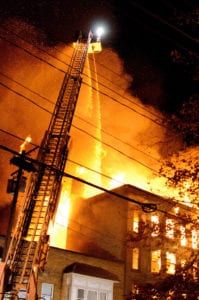 Imagine for a moment that you’re part of a 4-person first-due crew responding on to an apartment fire. On the way to the call the dispatcher announces over the radio that a caller is reporting the fire to be on the first floor of a three-story apartment building. Your company officer tells you that on arrival she’s going to conduct a 360-degree size-up while the crew pulls a 1 ¾” attack line. As you sit there in the jump seat you go over in your mind the steps of the things you’re going to do when you arrive.
Imagine for a moment that you’re part of a 4-person first-due crew responding on to an apartment fire. On the way to the call the dispatcher announces over the radio that a caller is reporting the fire to be on the first floor of a three-story apartment building. Your company officer tells you that on arrival she’s going to conduct a 360-degree size-up while the crew pulls a 1 ¾” attack line. As you sit there in the jump seat you go over in your mind the steps of the things you’re going to do when you arrive.
No sooner are you done making your mental game plan when the dispatcher announces over the radio that additional callers have reported flames on the second floor and there are people trapped on the third floor. From the officer’s seat comes a new set of orders. The crews are going to be split. Two firefighters pull the attack line – Two firefighters set a ladder to the third floor window in preparation for the rescue. As the reports from dispatch changed, so did the game plan and the entire crew was on-board with the changes… no second thoughts… no questions asked.
 Switch gears now. Imagine you’re no longer on the engine responding to an apartment fire. Now you’re arriving at the station for a department meeting. As you walk through the door into the apparatus bay, you cannot believe your eyes! Someone has moved the engine! What?!?! That’s right. The engine, which is usually in the first bay, is now in the second bay and the ambulance, which is usually in the second bay is now in the first bay. You start breathing hard. You feel your blood pressure rising. Your face is getting red. You are nearing the point of being overcome with anger.
Switch gears now. Imagine you’re no longer on the engine responding to an apartment fire. Now you’re arriving at the station for a department meeting. As you walk through the door into the apparatus bay, you cannot believe your eyes! Someone has moved the engine! What?!?! That’s right. The engine, which is usually in the first bay, is now in the second bay and the ambulance, which is usually in the second bay is now in the first bay. You start breathing hard. You feel your blood pressure rising. Your face is getting red. You are nearing the point of being overcome with anger.
Is this an over dramatization? Not at all. I have heard similar stories from firefighters about a co-worker overreacting to the most insignificant changes (or what appeared at the time to be insignificant changes) that have taken place in the firehouse. Some, I’m told, have even resulted in fist fights. So how is it that firefighters can be so resilient to the changing conditions at the scenes of emergency calls yet can be so resistant to minor changes that occur in the firehouse? It hardly makes sense.
There really is no mystery as to why an individual would react so differently to very similar circumstances (i.e., changing environmental conditions). It can be summed up in just one word – control.
Back to the fire example, as the crew was responding and when they first arrive on the scene, they sized things up. The crew, for the most part, is not in control of what is happening. The fire is in control. And no self-respecting firefighter isn’t going to like that… giving up control to the fire. Firefighters are action-oriented. It is not in a firefighter’s genetic make-up to sit back and let a fire burn without a fight. So they attack! They launch an assault to neutralize the enemy – the fire.
 So the firefighters take control! And when they’ve beat down the flames, they feel good. They slap backs, give high-fives and they grunt. (It’s a primal response dating back to when our cave dwelling ancestors celebrated victory over Jurassic foes.)
So the firefighters take control! And when they’ve beat down the flames, they feel good. They slap backs, give high-fives and they grunt. (It’s a primal response dating back to when our cave dwelling ancestors celebrated victory over Jurassic foes.)
Ok… back to the firehouse. You walk into the station and you size things up. The trucks aren’t where they’re supposed to be! Again you are, for the most part, not in control of what’s happening here. Someone else is in control. Someone moved the fire truck without your input. And you don’t like that one bit! Remember, you are an action-oriented firefighter. It is not in your genetic make-up to sit back and let someone change something you don’t like without a fight. So you attack! As with the fire, you launch an assault to neutralize the enemy (in this case, the person who made this absurd change). You take control! And when you have beaten the person who made the change into a pulp, you feel good. You slap backs, give high-fives and you grunt.
Feel like you just had a déjà vu experience when you read those last two paragraphs? In the psychology books, the response that people display when confronted with something that makes them scared is known as the Fight or Flight Response. When faced with something that is a threat, a person will either stand up and fight… or run away (flight). Unfortunately for fire departments (and the citizens they serve), most fire departments are flush with firefighters who would rather stand up and fight than run away. The good news is, those types of people make great firefighters. The bad news is, they can beat the snot out of decision makers when they do not like changes that take away their control.
If you’re department doesn’t have problems like this, you’re doing things right. Congratulations! You can stop reading here go on to the next article, or you can just continue to read on out of morbid curiosity to see what the others can learn about how to deal with those action-oriented change resisters.
There are a number of explanations for why people resist change. Here are some of the more popular reasons and some solution-oriented ideas (with a few offered tongue in cheek) for how to deal with them.
Self interest
Yes, believe it or not, within your fire department there are some people who put their own self interest above the needs of the department or the needs of the community. I know… you’re shocked! The best way to deal with this type of change resistor is to keep them focused on the fire department’s mission statement. This person may need some regular reminders that the needs of the department and the needs of the community come first. Chances are they knew this when they first joined the department but somewhere along the way they got out of focus.
Service above self would be a good message to carry to this person. The challenge for you is to help this person get back on track. It may be helpful to understand what caused them to fall off track in the first place. Talk to them and chances are you’ll find they are harboring some hard feelings about something that happened along the way. Giving them a chance to unload their feelings may go a long way toward helping them to see how out of focus they have become. The important thing, for the health of the department and those who have to work with this person, is to help him get back in focus – a focus that includes reconnecting with the department’s mission and purpose and a fresh commitment to the role they play.
If things become drastic, try taping the department’s mission statement to the front of his locker, on the windshield of his car, on his coffee cup… anywhere that helps him stay focused on the organization’s mission and purpose. When he does things that support mission and purpose be sure to acknowledge it and offer praise.
Anxiety
 Some people get very uptight anytime there’s any change in their lives. These people need attention and nurturing. They need proverbial hand-holding. They need to have their fears eased. These people are truly amazing to watch. In a department meeting the chief may announce a very minor change and these people won’t sleep all night. And by morning the chief will have an e-mail waiting for him with 10 reasons why the change won’t work.
Some people get very uptight anytime there’s any change in their lives. These people need attention and nurturing. They need proverbial hand-holding. They need to have their fears eased. These people are truly amazing to watch. In a department meeting the chief may announce a very minor change and these people won’t sleep all night. And by morning the chief will have an e-mail waiting for him with 10 reasons why the change won’t work.
The key to working with this person is to understand what is causing their anxiety and talk it through with them. Many times the anxiety is unfounded, as some people spend significant amounts of time worrying about things that never happen.
Fear of failure
The human ego can be very powerful. In fact, in some, it’s overpowering. But it can also be very fragile. It’s almost an oxy-moron to say that something can be so powerful, yet so fragile. But that’s how the ego is.
Chances are you’ve seen a person with a big, fragile ego in action. In the process of introducing a change in a department meeting, someone starts screaming at the chief from the back of the room (these people NEVER sit in the front of the room), calling the chief names and threatening anything from quitting to making sure the chief loses the next election. Believe it or not, what they’re really saying is “I’m afraid.” Afraid?!?
Yes… they are afraid. They are afraid of failure. But their ego won’t allow them to be honest enough to admit that publicly. So, instead, they attack the chief. If you could get them alone and calmed down long enough to ask them what they’re afraid of… and if they didn’t punch you in the nose for even asking… they might admit to you that they are afraid of failure. Maybe they are afraid they cannot learn the new stuff or they won’t be able to adapt to the new procedure.
For them, it’s not so much about knowing how to do something as it is not looking like a fool for not knowing how to do something. You can offer them some special one-on-one time to help them learn and master the new way of doing things. It can also be good for their fragile ego to allow them to help teach newer members things they know a lot about.
Differences of opinion
 If your department has a hundred members then you know one thing for sure. There are a hundred opinions about how to do something. It is rare to meet a firefighter who does not have an opinion on any topic being discussed (unless it’s a significant other asking for advice about how a certain outfit looks on them).
If your department has a hundred members then you know one thing for sure. There are a hundred opinions about how to do something. It is rare to meet a firefighter who does not have an opinion on any topic being discussed (unless it’s a significant other asking for advice about how a certain outfit looks on them).
People having and sharing different opinions is not always a bad thing. In fact, it can actually be a very good thing. It is an indication of a healthy organization where members feel free to disagree (without being disagreeable). This can lead to healthy debates and help improve the quality of decisions being made. Unfortunately, some firefighters are pontificating, self-righteous, never wrong, hot-air balloons who want to argue for the sake of the argument.
These people are counter-productive and need to be dealt with. Neutralize their acidic behavior by inviting them to meet after the meeting, one-on-one in the office or a private location. Explain to them the ground rules for a healthy debate and the expectations of professional behavior. Make sure they know where the line is and that they will be held accountable for behavior that is discourteous or unprofessional.
Relationships with officers/supervisors
It’s certainly easer to adapt to change if you are going through it with officers and supervisors you get along with. An understanding and sympathetic boss will help you when you feel the anxiety, anger and fear that may accompany major change.
If someone’s having a difficult time and you think it’s because of a supervisor or officer, try matching the person up with another officer or supervisor to serve as their mentor or confidant. Someone who’s miserable over change is more likely to confide in someone they trust and respect. This beats having them hold in their feelings and then one day explode into cosmic pieces because the stress of change got the best of them.
Status quo
Some people just want to be left alone. They like their life and their fire department just the way it is. If you listen closely, you might hear them praying… “The way it is… is the way it was… is the way it will always be… and for that, I am grateful, Amen.” Before you criticize them, take a look in the mirror. Everyone, to some extent, are creatures of habit and would prefer that certain things be left alone. Another thing that may be obvious, but is worth pointing out, it that is much easier to accept change when you are the creator of the change. As the creator, you have total control over the change.
It’s altogether different to accept change when it’s being heaped upon you from someone else and you have no control over it. Even the most change resilient people have things in their lives that they like to see remain unchanged. Maybe it’s their morning routine getting ready for work. Or maybe it’s stopping at the same place each morning to get coffee. Everyone knows the things they like and don’t want changed.
Everyone can probably recall a time when they were anxious, angry or fearful because something they had become comfortable with was suddenly changed without their knowledge or approval. So, before you go out looking for a tall oak tree to hang the person with status quo-itis, reflect on a time in your past (or present) when you faced an uncomfortable change and remember how it made you feel.
 Assume for a moment that the worst case of status quo-itis in your department isn’t a terminal case. In other words, the person still driving a 1971 Pinto, wearing 40” bell bottoms and listening to Sonny and Cher tapes on the 8-track player. If they are terminal… about the only thing you can do is buy them some fuzzy dice for the rear view mirror, get them a tie-died shirt to wear with the bells and hum “I got you babe” when they are in the room.
Assume for a moment that the worst case of status quo-itis in your department isn’t a terminal case. In other words, the person still driving a 1971 Pinto, wearing 40” bell bottoms and listening to Sonny and Cher tapes on the 8-track player. If they are terminal… about the only thing you can do is buy them some fuzzy dice for the rear view mirror, get them a tie-died shirt to wear with the bells and hum “I got you babe” when they are in the room.
If they’re not terminal, you can appeal to their sense of reason, reminding them of all the things that have changed, both within and outside the fire department, over the past 10 years. Hopefully that’s an easy list to assemble. Talk with them about how they coped and adjusted to each of those changes and how they overcame their anxiety, anger and fear.
As a visual aid to remind them that change happens all the time and they can adapt, tape a picture of a 1971 Pinto to their locker. If they look at it and say “those were the good ole days,” there’s hope. If they look at it and say “Hey! Who took this picture of my car?”, you might need to remind them that 27 people died in fuel tank rupture-related fires during the 1970’s in Ford Pintos and suggest that it’s time to move on. Tape an ad for a 1986 Ford Taurus in their locker. Remember… baby steps.
Change is inevitable in everyone’s life. You cannot escape it. But you can resolve to be more understanding and patient of those who struggle with and resist change. Equally, you can vow to continue your tenacity to change the things that improve the service you provide to your communities, regardless of the resistance you encounter.
[This contribution is an excerpt from Dr. Gasaway’s leadership book “On Fire About Leaderhsip.”]
_____________________________________________________

If you are interested in taking your understanding of situational awareness and high-risk decision making to a higher level, check out the Situational Awareness Matters Online Academy.
CLICK HERE for details, enrollment options and pricing.
__________________________________
Share your comments on this article in the “Leave a Reply” box below. If you want to send me incident pictures, videos or have an idea you’d like me to research and write about, contact me. I really enjoy getting feedback and supportive messages from fellow first responders. It gives me the energy to work harder for you.
Thanks,

Email: Support@RichGasaway.com
Phone: 612-548-4424
SAMatters Online Academy
Facebook Fan Page: www.facebook.com/SAMatters
Twitter: @SAMatters
LinkedIn: Rich Gasaway
YouTube: SAMattersTV
iTunes: SAMatters Radio

